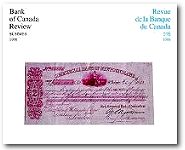Summer 1998

|
Recent economic and financial developments (with update on 12 August 1998) by Bank staff
Labour force participation in Canada: Trends and shifts
The declining supply of treasury bills and the Canadian money market
|
Cover: Bill of exchange, Commercial Bank of Newfoundland
The National Currency Collection contains many fiduciary documents such as cheques, promissory notes, letters of credit, and drafts or bills of exchange like this one.
The sale of bills of exchange made a handsome profit for 19th-century Canadian banks. To settle their debts, merchants purchased exchange from banks—a cheap and secure alternative to sending cash to their creditors.
A bill of exchange is an order to pay and involves three parties: a drawer, a drawee, and a payee. Typically, the drawee is in debt to the drawer who, in turn, is in debt to the payee. Thus, the bill of exchange settles two debts. If we use this bill of exchange as an example, the Commercial Bank of Newfoundland (the drawer), acting on behalf of the real debtor who purchased this exchange from the bank, owes the money to Messrs Baker & Gibson (the payee). The Commercial Bank, however, is itself owed money by the London & Westminster Bank Ltd. (the drawee). The Commercial Bank, by means of this bill, orders the London & Westminster Bank Ltd. to discharge its debt to the Commercial Bank by paying the Commercial Bank's debt to Messrs Baker & Gibson.
A bank usually issued two or three copies of a draft in its own name, signed by senior officers and drawn upon its correspondent bank. These extra copies were necessary since ships could sink before reaching port. However, only the first copy to arrive at the destination was honoured; the others served as receipts if necessary.
Because these bills of exchange, or drafts, were endorsed and passed from one party to another, they had to be as durable and secure as bank notes. Thus, security printers often produced them using the same paper, inks, and printing techniques used for notes.
This bill of exchange is from the Commercial Bank of Newfoundland (1857–1894), measures approximately 23 cm by 11 cm, and is part of the National Currency Collection at the Bank of Canada.
Photography by James Zagon.




